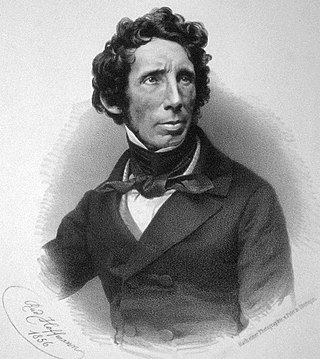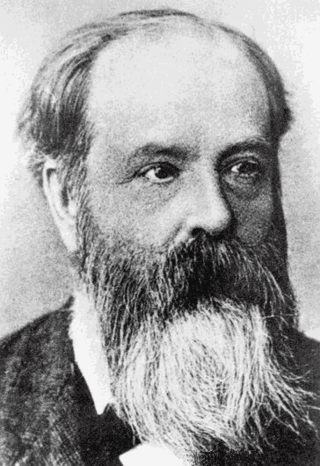Related Research Articles

Friedrich Wöhler FRS(For) HonFRSE was a German chemist known for his work in both organic and inorganic chemistry, being the first to isolate the chemical elements beryllium and yttrium in pure metallic form. He was the first to prepare several inorganic compounds, including silane and silicon nitride.

Justus Freiherr von Liebig was a German scientist who made major contributions to the theory, practice, and pedagogy of chemistry, as well as to agricultural and biological chemistry; he is considered one of the principal founders of organic chemistry. As a professor at the University of Giessen, he devised the modern laboratory-oriented teaching method, and for such innovations, he is regarded as one of the most outstanding chemistry teachers of all time. He has been described as the "father of the fertilizer industry" for his emphasis on nitrogen and minerals as essential plant nutrients, and his popularization of the law of the minimum, which states that plant growth is limited by the scarcest nutrient resource, rather than the total amount of resources available. He also developed a manufacturing process for beef extracts, and with his consent a company, called Liebig Extract of Meat Company, was founded to exploit the concept; it later introduced the Oxo brand beef bouillon cube. He popularized an earlier invention for condensing vapors, which came to be known as the Liebig condenser.
George Green was a British mathematical physicist who wrote An Essay on the Application of Mathematical Analysis to the Theories of Electricity and Magnetism in 1828. The essay introduced several important concepts, among them a theorem similar to the modern Green's theorem, the idea of potential functions as currently used in physics, and the concept of what are now called Green's functions. Green was the first person to create a mathematical theory of electricity and magnetism and his theory formed the foundation for the work of other scientists such as James Clerk Maxwell, William Thomson, and others. His work on potential theory ran parallel to that of Carl Friedrich Gauss.
The year 1900 in science and technology involved some significant events, listed below.

The year 1820 in science and technology involved some significant events, listed below.
The year 1825 science and technology involved some significant events, listed below.
The year 1832 in science and technology involved some significant events, listed below.
The year 1837 in science and technology involved some significant events, listed below.
The year 1835 in science and technology involved some significant events, listed below.
The year 1841 in science and technology involved some significant events, listed below.
The year 1842 in science and technology involved some significant events, listed below.
The year 1927 in science and technology involved some significant events, listed below.
The year 1923 in science and technology involved some significant events, listed below.
The year 1873 in science and technology involved some significant events, listed below.
The year 1803 in science and technology involved some significant events.
The year 1882 in science and technology involved some significant events, listed below.

Frederick Guthrie FRS FRSE was a British physicist, chemist, and academic author.

"An Essay on the Application of Mathematical Analysis to the Theories of Electricity and Magnetism" is a fundamental publication by George Green in 1828, where he extends previous work of Siméon Denis Poisson on electricity and magnetism. The work in mathematical analysis, notably including what is now universally known as Green's theorem, is of the greatest importance in all branches of mathematical physics. It contains the first exposition of the theory of potential. In physics, Green's theorem is mostly used to solve two-dimensional flow integrals, stating that the sum of fluid outflows at any point inside a volume is equal to the total outflow summed about an enclosing area. In plane geometry, and in particular, area surveying, Green's theorem can be used to determine the area and centroid of plane figures solely by integrating over the perimeter.
Events from the year 1828 in Scotland.

The 19th century in science saw the birth of science as a profession; the term scientist was coined in 1833 by William Whewell, which soon replaced the older term of (natural) philosopher.
References
- ↑ "April 27". Today in Science History. Retrieved December 20, 2011.
- ↑ "Justus von Liebig and Friedrich Wöhler". Science History Institute.
- ↑ Bowden, Mary Ellen (1997). "Justus von Liebig and Friedrich Wöhler". Chemical achievers: the human face of the chemical sciences . Philadelphia, PA: Chemical Heritage Foundation. pp. 83-87. ISBN 9780941901123.
- ↑ Spadaccini, Jim. "The Sweet Lure of Chocolate". Exploratorium . Retrieved March 3, 2014.
- ↑ Puschmann, Theodor. Handbuch der Geschichte der Medizin. Vol. 3. Jena. p. 384.
- ↑ Duncan, Henry (January 1828). "An Account of the Tracks and Footmarks of Animals found impressed on Sandstone in the Quarry of Cornockle Muir in Dumfriesshire". Transactions of the Royal Society of Edinburgh. 11 (1): 194–209. doi:10.1017/S0080456800021906 . Retrieved April 17, 2016. Published 1831.
- ↑ Green, George (1828). An Essay on the Application of Mathematical Analysis to the Theories of Electricity and Magnetism. Nottingham: T. Wheelhouse. Retrieved November 12, 2013.
- ↑ Ferrers, N. M. (ed.). Mathematical papers of the late George Green.
- ↑ Cannell, D. M. (1999). "George Green: An Enigmatic Mathematician". American Mathematical Monthly . 106 (2): 136–151. doi:10.2307/2589050. JSTOR 2589050.
- ↑ Gale, W.K.V. (1981). Ironmaking. Princes Risborough: Shire Publications. p. 22. ISBN 0-85263-546-X.
- ↑ Bevan, John (1996). The Infernal Diver: the lives of John and Charles Deane, their invention of the diving helmet and its first application... London: Submex. pp. 28–33. ISBN 0-9508242-1-6.
- ↑ Nicholson, Peter (1828). A Popular and Practical Treatise on Masonry and Stone-cutting. London: Thomas Hurst, Edward Chance & Company. pp. 39–60.
- ↑ Welch, Henry (1837). Loudon, John Claudius (ed.). "On the Construction of Oblique Arches". Architectural Magazine. IV. London: Longman, Orme, Brown, Green & Longman: 90.
The stones were cut, or dressed, previously to the erection of the centre
- ↑ Schofield, Reginald B. (2000). Benjamin Outram, 1764–1805: An Engineering Biography. Cardiff: Merton Priory Press. pp. 149–154. ISBN 1-898937-42-7.
- ↑ "Copley Medal | British scientific award". Encyclopedia Britannica. Retrieved July 22, 2020.
- ↑ "Notice no. LH//2582/41". Base Léonore (in French).